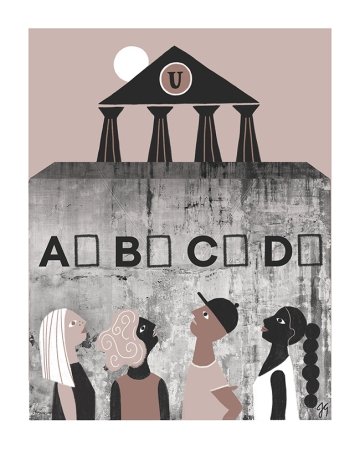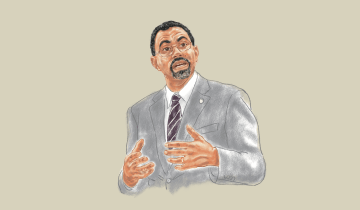It was early February, and Jefferson High School college counselor Enrique Carranza had been trying for days to reach one of his seniors by email and messages on the school networking service, the primary means of staying in touch while campuses across the Los Angeles Unified School District were closed.
When the student finally checked her inbox, she found not only Carranza’s messages but also one from California State University telling her she had been accepted to CSU Dominguez Hills this fall.
But what should have been an occasion for pure joy—she would be the first member of her family to attend college—instead was fraught with uncertainty.
Since COVID-19 turned everything upside down, she has been working as many as 30 hours a week at a fast-food restaurant to support her family through the pandemic. She intends to go to college, but until her family’s finances improve, she told Carranza, where and when are up in the air.
“These are the conversations counselors across Los Angeles are having with students,” said Carranza, who was hired onto Jefferson’s permanent staff after two years at the predominantly Latino/Latina, low-income campus as a member of the USC College Advising Corps.
The Jefferson High student’s plight reflects worrisome national trends that suggest the pandemic is deepening inequalities in college access for students from historically underrepresented groups.
“COVID-19 is affecting dramatically who goes to college and where they go to college,” said USC Rossier Professor of Practice Jerome Lucido, who directs the USC Rossier Center for Enrollment Research, Policy and Practice (CERPP). “It’s exacerbating the disadvantages of many populations.”
One of the most troubling signs of a growing equity gap is the sharp decline in financial aid applications.
“COVID-19 is affecting dramatically who goes to college and where they go to college. It’s exacerbating the disadvantages of many populations.” —Jerome Lucido, USC Rossier Professor of Practice
The number of students who have submitted the federal form known as the FAFSA (Free Application for Federal Student Aid) in February compared to the same time last year has fallen by 12.3 percent at high schools with large enrollments of low-income students, as defined by the federal Title I program; by comparison, FAFSA submissions have dropped 7.4 percent at non-Title I schools, according to the nonprofit National College Attainment Network (NCAN). NCAN found a steeper decline, of nearly 15 percent, at schools with high proportions of students of color.
Although the gap has narrowed since FAFSA season opened in October, experts remain concerned.
These numbers are distressing to college-access advocates because research shows that students who submit the FAFSA are far more likely to attend college and receive a degree.
“We’re hoping for a late swell in FAFSA filings,” said Rakin Hall ME ’13, vice president of enrollment management at the private Arcadia University near Philadelphia. “The pandemic has really exposed a lot of gaps in resources at the K–12 level.”
Part of the problem may be unequal access to college counselors, who play a crucial role in the FAFSA filing process. High school counselors usually hold on-campus workshops to help students and parents wend their way through the long FAFSA form, but now they must do it on Zoom, a far more time-consuming affair that depends on families having a computer and reliable internet service.
“The counselors are really taxed,” Hall said. And, FAFSA filing is not the only college application requirement that is getting bogged down by the need to do it remotely. “Something as simple as a letter of recommendation is taking months,” Hall observed.
A further sign of the pandemic’s toll is the nearly 22 percent drop in the number of 2020 high school graduates who enrolled in college last fall, according to the National Student Clearinghouse Research Center. The drop-offs varied by type of institution, with the steepest decline seen at community colleges.
The center found that community college enrollment fell by 21 percent nationally, a rate of decline that was almost 20 times higher than during the pre-pandemic year of 2019. Because two-year colleges provide a crucial path into higher education for low-income and other marginalized students, the plummet is ringing alarm bells.
“It is scary,” said USC Rossier Professor of Education Tatiana Melguizo, who studies the economics of higher education. “Community colleges are engines of opportunity. If no one is reaching out to those students, they are going to postpone. And nobody knows if they will come back.”
Signs of hope?
While it’s too early to know this fall’s enrollment picture, worrying—and encouraging—trends are emerging in data about the widely used Common Application.
The early numbers show that applications at the nation’s most elite institutions, both public and private, are booming. Freshman applications at top colleges and universities, such as UCLA, Harvard and Penn State, have surged by 17 percent overall compared with the previous year, according to the Common App. Some campuses have reported growth of 20 percent or more, with significant increases among Black and Latino/Latina applicants.
USC is expecting about 70,000 applications for this fall’s freshman class, a 2 percent rise over last year and a 7 percent increase over the previous high in 2019–20, USC spokesman Ron Mackovich said.
Admissions experts have attributed the higher-than- decision that caused seniors to sigh in relief: About 1,700 colleges and universities, including USC, scrapped the SAT/ACT requirement for at least this year because of the closure of testing centers during the pandemic. Some experts predict that the requirement will eventually be eliminated permanently.
“Instead of disqualifying themselves from applying because they think their scores aren’t good enough, students are saying, ‘I’m going to go for it,’” said Alyssa Orrantia Bieneme, Cornell University’s associate director of admissions and coordinator of diversity outreach, who will complete a master’s degree in enrollment management policy at USC Rossier this spring.
At Cornell, freshman applications are up by more than 16,000 this year. A contributing factor may be the shift to virtual recruiting: Cornell, like USC and other highly competitive institutions, hosted information sessions online, which enabled them to reach many more high schools than was possible when in-person campus visits were the norm.
“This has been surprisingly beneficial,” Bieneme said, and may have contributed to a significant rise in applications to Cornell from historically underserved students.
Even before the pandemic, some institutions declared themselves test-blind, meaning that they do not look at scores even if applicants submit them. More schools have chosen the test-optional route, meaning that they are not requiring scores but will consider them if submitted.
The movement toward test-optional or test-blind policies is the biggest change in college admissions in the COVID-19 age. It will be a cause for major celebration if it ends up leveling the playing field for poor, Black and Latino/Latina students, whose low average scores have been linked to lack of access to costly test-prep courses.
But that is a big “if.”
“Test-optional and test-blind operate alongside a host of factors affecting enrollment,” said USC Rossier Associate Professor of Higher Education Julie Posselt. “In many places the move to test-optional seems to be associated with an uptick in applications.
What’s not clear is whether there are countervailing factors that might still pose barriers to students being admitted and ultimately enrolling,” such as the desirability of their extracurricular activities and ability to write a compelling personal statement.

“There are lots of ways that privilege and cultural capital show up in admissions,” Posselt said. Some admissions professionals say that waiving the test-scores requirement will not radically alter the process because they approach applications holistically, meaning that no one indicator of merit will determine a student’s admissions status. This year, the Common App also includes space for applicants to describe how the pandemic may have affected them.
“We have always approached the review of applications holistically and compassionately, understanding the challenges many students and families face,” Cornell’s Bieneme said.
Don Hossler, a senior scholar at USC Rossier’s CERPP, said removing test scores, no matter how problematic, from the equation could make it even harder for students and parents to understand how admissions decisions are made.
He helped lead a recent study of 10 institutions with different levels of selectivity that emphasize a holistic approach to admissions. The study found that no school used the same criteria and processes when making admissions decisions.
“Not only will low- and moderate-income students not understand the rules of the game, but the process will become less transparent to all students,” Hossler wrote in a recent op-ed. “This should give all of us pause.”
If test scores are off the table this year, what factors might come in for greater scrutiny?
Bieneme said assessments of academic rigor, such as whether students took advantage of any available Advanced Placement courses, will be a key factor in Cornell’s holistic review process, as it was before the pandemic’s disruptions. Essays may also receive greater scrutiny.
“I think that this year of all years, [applicants] should pay particular attention to the writing that they submit to colleges,” USC Dean of Admission Timothy Brunold said in October.
At Arcadia University, Hall said admissions decisions will lean more heavily on grades.
“I’ve always been a huge fan of GPA,” he said. “The SAT is a snapshot of a student’s day—could be a good day or a bad day. GPA tells me how you show up in life. Isn’t that what it’s about, how you show up at 8 a.m. or 8 p.m.? [It tells me], ‘Are you ready?’”
“I also like the idea of letters of recommendation,” Hall added. “GPA indicates consistency. Letters of recommendation speak to your character.”
“COVID-19 and the racial uprising unveiled the unequal opportunities for our students … a whole reckoning with the idea of merit.” —Tatiana Melguizo, USC Rossier Professor of Education
College advisers say they hope admissions officers will take personal context into account when assessing applicants from disadvantaged communities.
“I’m happy to hear from some of them that they are definitely looking at senior year with a grain of salt,” said Ara Arzumanian, program director of the USC College Advising Corps, which aims to improve college outcomes for low-income, first-generation and underrepresented students by providing understaffed Los Angeles high schools with qualified counselors. “They’re trying to figure out what happened to the students, how much of what they see on the transcript is related to the pandemic or the fact they don’t have Wi-Fi or a place to do classwork at home.”
Forging a new path
Many experts hope the pandemic, along with last year’s Black Lives Matter protests, may finally lead to a wholesale rethinking of college admissions that improves equity in college outcomes.
“COVID-19 and the racial uprising unveiled the unequal opportunities for our students … a whole reckoning with the idea of merit,” Melguizo said.
“It hit our most vulnerable communities harder, so we have families who have first responders who need to be at work every day, and we have parents who are able to work from home and who are going to give as much as they can afford to make their kids more competitive. As institutions, we need to think about that. We need to think about ways to expand educational opportunity. Otherwise, we are maximizing these inequities.”
Melguizo would like to see higher education, especially the most elite institutions, find better ways to identify the most promising students from disadvantaged communities, and create and fund programs that give them the greatest chance for college success.
One approach she admires is the USC McMorrow Neighborhood Academic Initiative, a seven-year precollege program that prepares students from South and East Los Angeles for admission to a college or university. Since its first graduating class in 1997, 83 percent of the more than 1,000 participants have enrolled as freshmen at four-year institutions, including 42 percent at USC.
Another model is the Thompson Scholars Learning Communities, a comprehensive, college-transition program based at the University of Nebraska. A residential program that combines academic and social support, scholarships and individualized attention in the first two years of college, it has improved the graduation rates of low-income and racially minoritized students.
“When you give the resources and the emotional support, these students thrive,” said Melguizo, who has studied the Thompson Scholars program.
Such initiatives are expensive, but USC Rossier scholars are examining new ways to pay for them.
At CERPP, Lucido and his colleagues are launching an effort to design a federal program that would provide colleges and universities with greater financial support if they commit to admitting and graduating more underserved students. It targets federal Pell Grants, which flow to institutions without requiring them to ensure that the recipients persist to graduation. Lucido would like to make those institutions more accountable.
“Colleges may chafe at such a federal requirement, but there is ample data to show that higher education as a sector has not stepped up to move these students forward and advance social mobility in America in any way that meets current need,” he said.
“I don’t know an admissions officer who doesn’t want to do better on the equity front, but they feel so many constraints in getting that done,” he said. “So we really need the kind of restructuring and breaking down of barriers that have prevented them from opening doors wider.”







